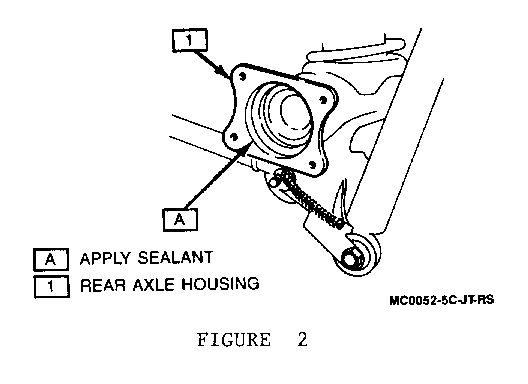SERVICE MANUAL UPDATE-SEC.5C REAR BRAKE BACKING PLATE

SUBJECT: SERVICE MANUAL UPDATE SECTION 5C REAR DRUM BACKING PLATE (REMOVAL/REPLACEMENT PROCEDURE)
VEHICLES AFFECTED: 1989-90 TRACKER
This bulletin cancels and supersedes the "Backing Plate" removal and installation procedures found on Page 5C-8 of the 1989 Tracker Service Manual, and on page 5C-4 in the 1990 Tracker Service Manual. Refer to this bulletin for information concerning removal and installation of the rear drum brake backing plate.
BACKING PLATE - Refer to Figures 1 and 2)
Tools Required: J 2916-01 Slide Hammer J 37781 Adapter
Raise and suitable support vehicle. Refer to General Information (Section OA).
1. Brake drum. Refer to "Brake Drum" in Drum Brake Assembly (Section 5C) in the 1989 or 1990 Tracker Service Manual.
2. Brake shoes. Refer to "Brake Shoes" in drum Brake Assembly (Section 5C) in the 1989 or 1990 Tracker Service Manual.
3. Wheel cylinder. Refer to "(Wheel Cylinder" in Drum Brake Assembly (section 5C) in the 1989 or 1990 Tracker Service Manual.
* Drain rear differential fluid. Refer to Rear Differential (Section 4D2) in the 1989 or 1990 Tracker Service Manual.
4. Wheel bearing nuts from rear axle housing.
5. Rear axle shaft using a J 2619-01 slide hammer with a J 37781 adapter, as shown in Figure 1.
6. Four backing plate nuts.
7. Backing plate.
INSTALL OR CONNECT
Apply GM #992708, or equivalent sealant to axle housing mating surface, refer to Figure 2.
1. Backing plate.
2. Four backing plate bolts.
TIGHTEN
* Four backing plate nuts to 22 N.m (16 ft.lbs.)
3. Rear axle shaft.
4. Wheel bearing retainer nuts to rear axle housing.
TIGHTEN
* Wheel bearing retainer nuts to 23 N.m (17 ft.lbs.).
5. Wheel cylinder. Refer to "Wheel Cylinder" in Drum Brake Assembly (Section 5C) in the 1989 or 1990 Tracker Service Manual.
6. Brake shoes. Refer to "Brake Shoes" in Drum Brake Assembly (Section 5C) in the 1989 or 1990 Tracker Service Manual.
7. Refill rear differential fluid. Refer to Rear Differential (Section 4D2) in the 1989 or 1990 Tacker Service Manual.
* Refill rear differential fluid. Refer to Rear Differential (Section 4D2) in the 1989 or 1990 Tracker Service Manual.
* Bleed brake system. Refer to Brake (Section 5) in the 1989 or 1990 Tracker Service Manual.
* Lower vehicle.


General Motors bulletins are intended for use by professional technicians, not a "do-it-yourselfer". They are written to inform those technicians of conditions that may occur on some vehicles, or to provide information that could assist in the proper service of a vehicle. Properly trained technicians have the equipment, tools, safety instructions and know-how to do a job properly and safely. If a condition is described, do not assume that the bulletin applies to your vehicle, or that your vehicle will have that condition. See a General Motors dealer servicing your brand of General Motors vehicle for information on whether your vehicle may benefit from the information.
